Voroneț Monastery was built in 1488 in just 3 months and 3 weeks and is nicknamed the Sistine Chapel of the East due to the fresco on the west facade showing the Last Judgment. Thanks to the working technique applied by Moldovian painters, the so-called Voroneț blue is not only known for the nature of the blue pigment, but also for its resistance to climatic conditions, coping with the centuries that have passed over it. The wonderful color comes from a secret recipe that is based on a mineral called azurite, thus becoming the most resistant color.
Distance from Casa Baciu: 44 km
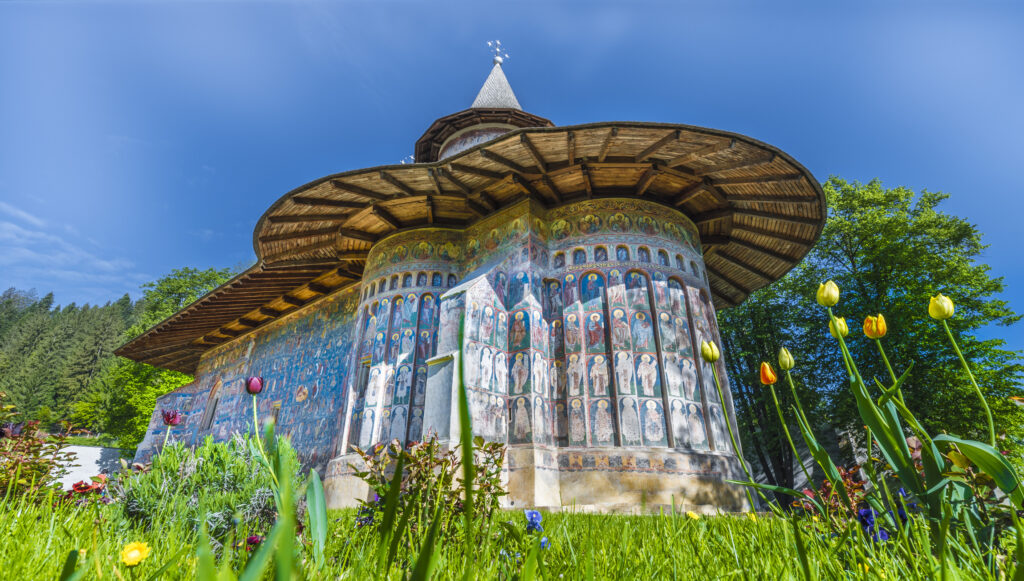
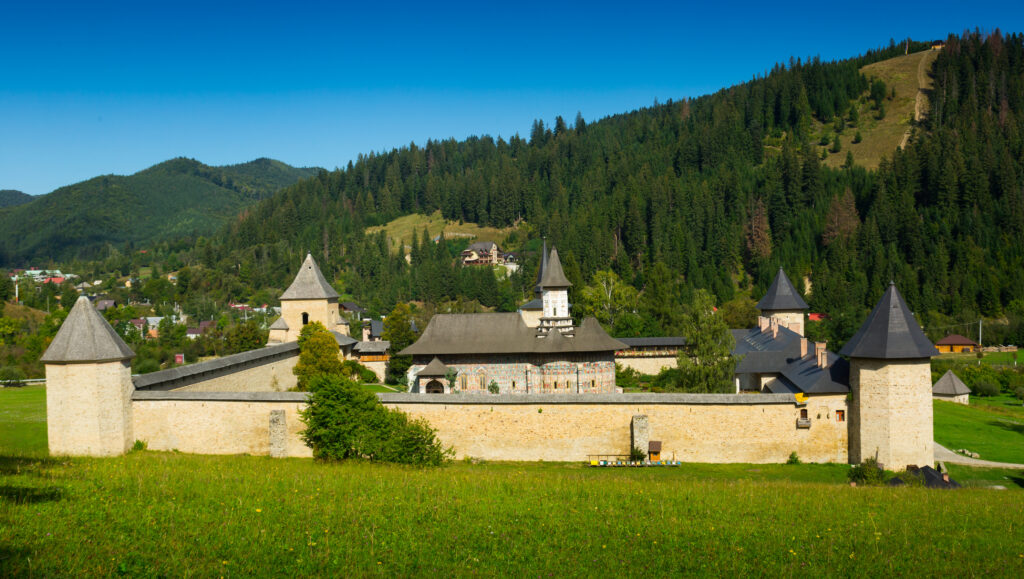
Orthodox nun only monastery, built over three years (1583 – 1586), in the style of Moldavian architecture, surrounded by six meters high and three meters thick walls. The architecture combines elements of Byzantine and Gothic art, to which are added architectural elements of the old wooden churches of Moldova. The interior and exterior wall painting is of great artistic value, being an extensive biblical narrative from the Old and New Testaments.
Distance from Casa Baciu: 58 km
Founded in 1532, the Moldovița Monastery impresses with the paintings on the exterior walls, where red-brown colors predominate and religious, historical or cultural scenes are illustrated. Of all the Bucovina churches, the exterior paintings here have been preserved the best. The paintings on the exterior walls are authentic frescoes, post-Byzantine style with Renaissance influences. Among the biblical figures that can be found painted, we can highlight images of Aristotle, Sophocles, Plato and Pythagoras.
Distance from Casa Baciu: 28 km
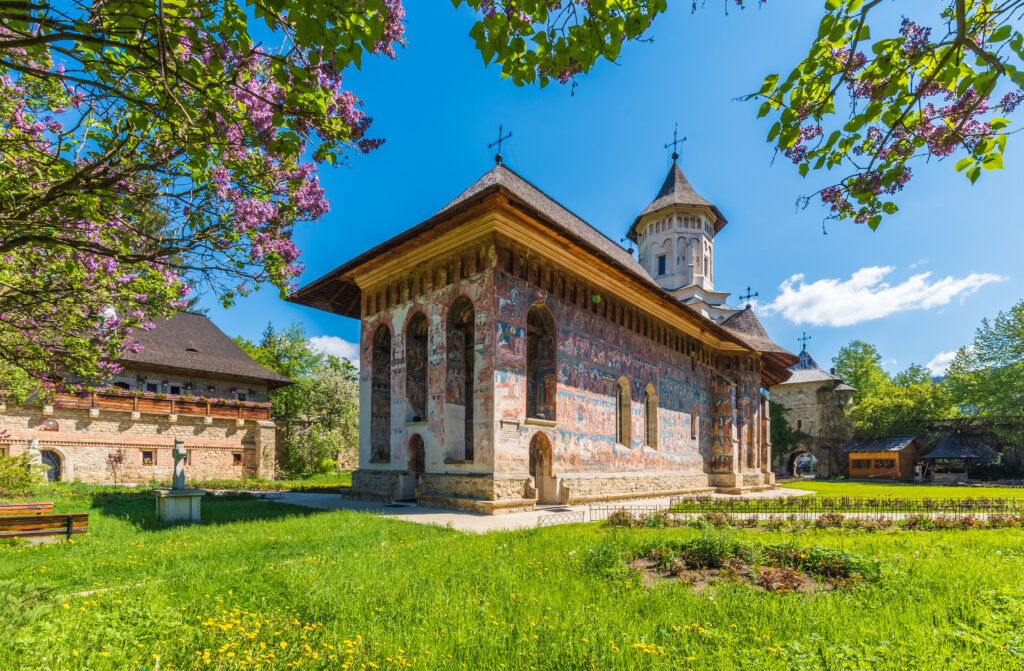
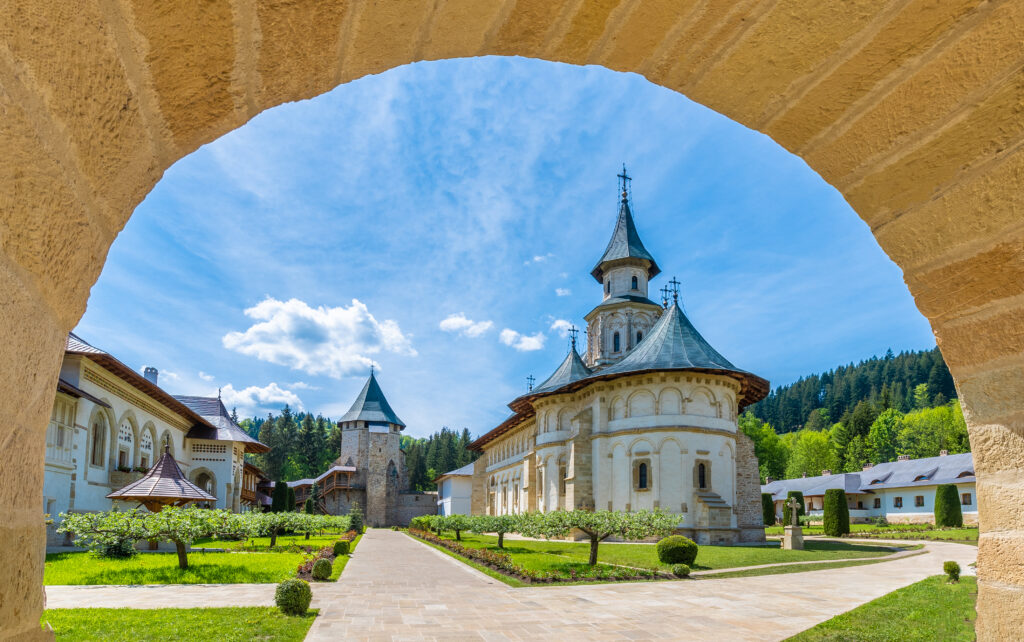
It represents one of the most important Romanian religious and artistic cultural centers, being nicknamed the “Jerusalem of the Romanian Nation” by Mihai Eminescu in 1871. In addition to the church, the monastic complex also includes the gate tower, the bell tower, the cells, the chapel, the museum, the treasury tower, the stately house and the fortification wall that surrounds the premises. According to the old Moldavian chronicles, the construction of the monastery, founded by Stephen the Great (whose tomb is located here), began in 1466 and ended in 1469.
Distance from Casa Baciu: 94 km
The Wood Art Museum, located in Câmpulung Moldovenesc, was founded in 1936 and preserves the only ethnographic collection in Romania dedicated exclusively to wooden objects. The building that hosts the museum is a historical monument, built in 1900, when Bucovina was still under the administration of the Austro-Hungarian Empire. The museum has 19 exhibition halls with a heritage of over 15,000 wooden pieces (specifically XVIII-XX centuries) which includes tools, weapons, household objects, musical instruments, dowry chests, doors and also has an outdoor section. The outdoor section includes two traditional houses, one in the hut style, dating from the 17th century and the other from the mid-18th century. A must-see is the 400-year-old mountain cart for transporting wine!
Distance from Casa Baciu: 9 km
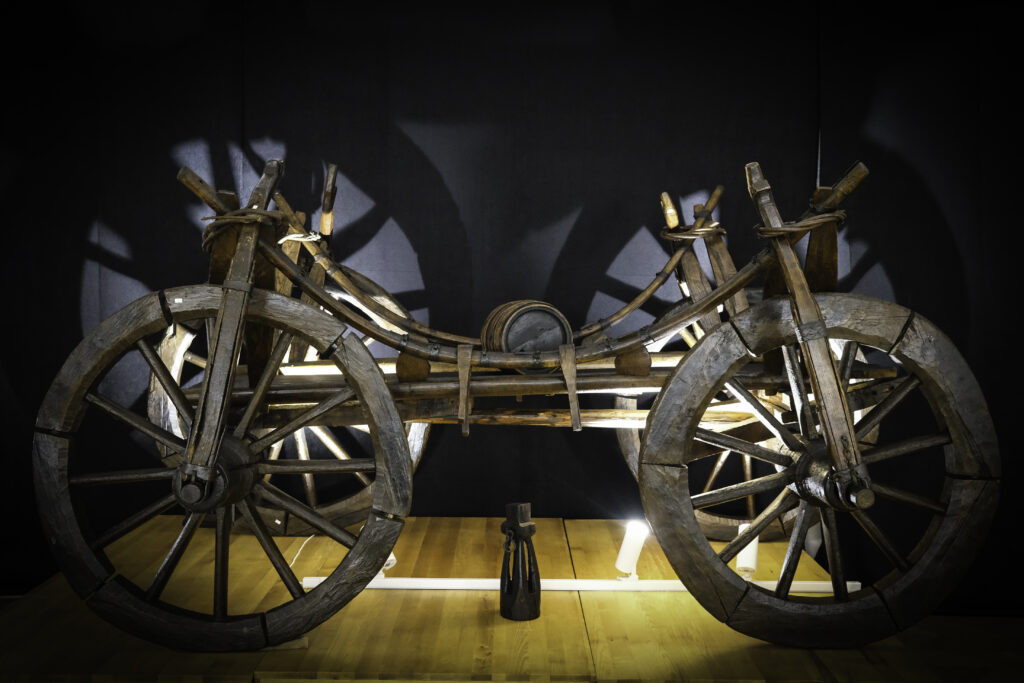
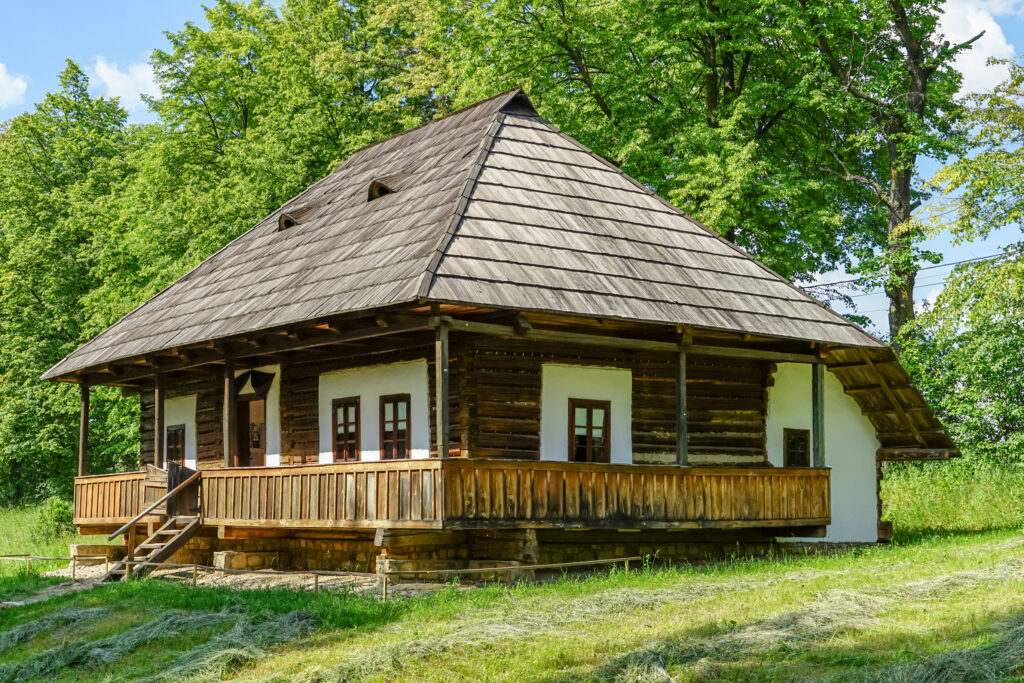
Bucovina Village Museum, located near The Fortress of Suceava, is an open-air museum, it covers an area of 6 hectares and has a number of over 30 traditional wooden houses, outbuildings, popular technical installations, workshops crafts and community building. The museum successfully illustrates the occupations, trades and crafts of the area and the way people lived in the past in Bucovina. In some of the houses, important spiritual events for bucovinians are illustrated, such as baptism, wedding or funeral. The traditional houses are equipped with ovens or stoves, inside there are elements of traditional furniture, interior textiles and pieces of folk wear that fully reflect the image of the traditional Bucovina civilization.
Distance from Casa Baciu: 79 km
Declared a cultural village and open-air museum in 2014, the village of Ciocăneşti is on the 6th place in a top 10 of the Lonely Planet travel guide of 2017, which designates the most colorful holiday destinations in Europe. With over 600 houses decorated on the outside with traditional patterns and with a practice of over 100 years in egg painting, Ciocănești village looks detached from a catalog which presents the ideal village, a guide to our national identity.
Distance from Casa Baciu: 28 km
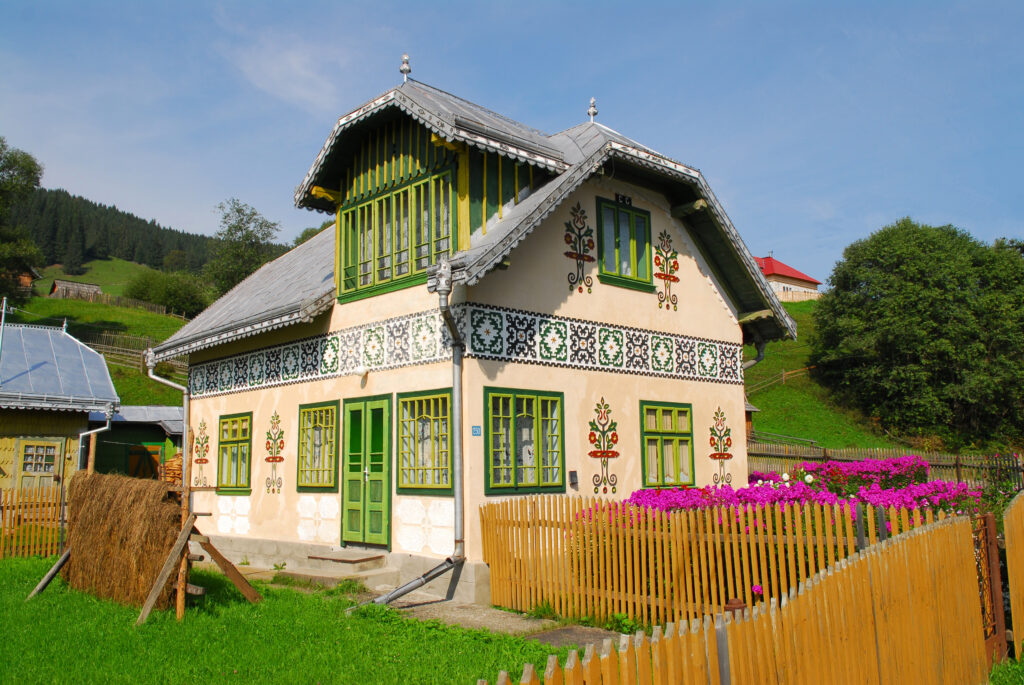

Voroneț Monastery was built in 1488 in just 3 months and 3 weeks and is nicknamed the Sistine Chapel of the East due to the fresco on the west facade showing the Last Judgment. Thanks to the working technique applied by Moldovian painters, the so-called Voroneț blue is not only known for the nature of the blue pigment, but also for its resistance to climatic conditions, coping with the centuries that have passed over it. The wonderful color comes from a secret recipe that is based on a mineral called azurite, thus becoming the most resistant color.
Distance from Casa Baciu: 44 km

Orthodox nun only monastery, built over three years (1583 – 1586), in the style of Moldavian architecture, surrounded by six meters high and three meters thick walls. The architecture combines elements of Byzantine and Gothic art, to which are added architectural elements of the old wooden churches of Moldova. The interior and exterior wall painting is of great artistic value, being an extensive biblical narrative from the Old and New Testaments.
Distance from Casa Baciu: 58 km

Founded in 1532, the Moldovița Monastery impresses with the paintings on the exterior walls, where red-brown colors predominate and religious, historical or cultural scenes are illustrated. Of all the Bucovina churches, the exterior paintings here have been preserved the best. The paintings on the exterior walls are authentic frescoes, post-Byzantine style with Renaissance influences. Among the biblical figures that can be found painted, we can highlight images of Aristotle, Sophocles, Plato and Pythagoras.
Distance from Casa Baciu: 28 km

It represents one of the most important Romanian religious and artistic cultural centers, being nicknamed the “Jerusalem of the Romanian Nation” by Mihai Eminescu in 1871. In addition to the church, the monastic complex also includes the gate tower, the bell tower, the cells, the chapel, the museum, the treasury tower, the stately house and the fortification wall that surrounds the premises. According to the old Moldavian chronicles, the construction of the monastery, founded by Stephen the Great (whose tomb is located here), began in 1466 and ended in 1469.
Distance from Casa Baciu: 94 km

The Wood Art Museum, located in Câmpulung Moldovenesc, was founded in 1936 and preserves the only ethnographic collection in Romania dedicated exclusively to wooden objects. The building that hosts the museum is a historical monument, built in 1900, when Bucovina was still under the administration of the Austro-Hungarian Empire. The museum has 19 exhibition halls with a heritage of over 15,000 wooden pieces (specifically XVIII-XX centuries) which includes tools, weapons, household objects, musical instruments, dowry chests, doors and also has an outdoor section. The outdoor section includes two traditional houses, one in the hut style, dating from the 17th century and the other from the mid-18th century. A must-see is the 400-year-old mountain cart for transporting wine!
Distance from Casa Baciu: 9 km

Bucovina Village Museum, located near The Fortress of Suceava, is an open-air museum, it covers an area of 6 hectares and has a number of over 30 traditional wooden houses, outbuildings, popular technical installations, workshops crafts and community building. The museum successfully illustrates the occupations, trades and crafts of the area and the way people lived in the past in Bucovina. In some of the houses, important spiritual events for bucovinians are illustrated, such as baptism, wedding or funeral. The traditional houses are equipped with ovens or stoves, inside there are elements of traditional furniture, interior textiles and pieces of folk wear that fully reflect the image of the traditional Bucovina civilization.
Distance from Casa Baciu: 79 km

Declared a cultural village and open-air museum in 2014, the village of Ciocăneşti is on the 6th place in a top 10 of the Lonely Planet travel guide of 2017, which designates the most colorful holiday destinations in Europe. With over 600 houses decorated on the outside with traditional patterns and with a practice of over 100 years in egg painting, Ciocănești village looks detached from a catalog which presents the ideal village, a guide to our national identity.
Distance from Casa Baciu: 28 km